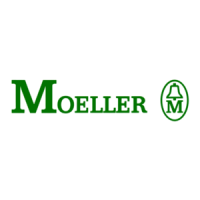01/02 AWB8230-1415GB
PID controller
145
Temperature control
With the flow control in the previous example, the frequency
inverter’s output frequency increases if the feedback signal is less
than the setpoint and falls if the feedback signal is greater than the
setpoint. With temperature control, the opposite behaviour must
be implemented: if the temperature is above the setpoint, the
inverter must increase its output frequency to increase the speed
of the connected fan.
The following figure contains an example for temperature control
with the two setpoints 20 and 30 °C:
Figure 144: Example of temperature control
w: Setpoint value, 4 Bit digital
x: Feedback actual value (50 °C at 10 V)
B1: Measured value converter
P1: Temperature sensor
a Fan
PNU
Meaning in PID control mode Value Notes
F001 Setpoint 20 Direct input of “20 °C”, as the scaling
factor has been set
A001
Frequency setpoint input 02 Keypad
A011
Feedback percentage actual value for lower acceptance threshold
(units: %)
100 100 %
A012
Feedback percentage actual value for upper acceptance threshold
(units: %)
0 0%
A013
Lower acceptance threshold for voltage or current on the actual value
input (in %)
0 0%
A014
Upper acceptance threshold for voltage or current on the actual value
input (in %)
100 100 %
A021
Digitally adjustable setpoint value 1 30 30 °C
A071
PID control active/inactive 01 PID mode active
A072
P component of the PID control – Application dependent
A073 I component of the PID control –
A074
D component of the PID control –
A075 Setpoint factor of the PID control 0.5 100 % at 50 °C
A076
Input actual value signal for PID control 01 Feedback from O-L terminal
w
B1
P1
x
0... +10 V H
G1
a
M
3
~
100%
0
4 V
40 %
10 V
100 %
60%
40%
6 V
60 %
20 °C
50 °C
30 °C
For Moeller Electric Sales and Support call KMparts.com (866) 595-9616

